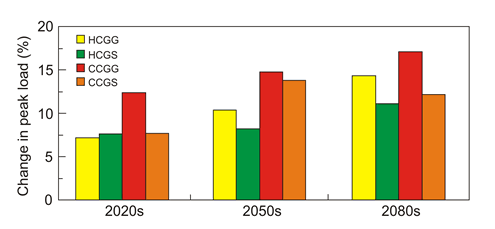|
|
 |  | 
| Print
this Brief |
| What major
climate change impacts are projected for the coming decades? |
| |
Key Points
The climate change impacts projected for the New York
metropolitan region will affect infrastructure, wetlands,
water supply, health, and energy demand. These impacts
interact in complex and dynamic ways because of the high
population density, heterogeneous ecosystems, and extensive
built infrastructure in the region. Impacts on the coastal
environment and coastal communities and on transportation
infrastructure in the metropolitan area are discussed in
greater detail in subsequent articles.
 |
| Figure
1. Shaded area represents the potential
height of floods from a Category 2 hurricane
at South Ferry (Battery) subway station. Source:
NYC Office of Emergency Management. |
|
Infrastructure
Most of the region’s low-elevation infrastructure,
including buildings and transportation networks, will be
at increased risk of flooding in coming decades. Figure
1 illustrates the height to which water may rise during
Category 2 hurricanes, which are projected to occur more
frequently. See How
will climate change affect the region’s transportation
system?
Wetlands
Some scenarios suggest that salt
marshes in the region are at risk of increased inundation
(Figure 2). Coastal wetland losses disrupt current habitats
of birds, fish, and other wildlife. For example, the salt
marshes of Jamaica Bay have experienced dramatic loss of
 |
| Figure
2. Rising sea level is contributing to
the erosion of wetlands. Source: Hartig
et al, Wetlands, in Climate Change and a
Global City, 2001. |
|
marshland during the twentieth century. This is probably
related to sea level rise already occurring in the region,
as well as to changes in land use, sedimentation, and pollution.
See How might climate
change affect the coastal environment and coastal communities?
Water Supply
Greater climate variability is
projected to lead to increases in the frequency of droughts
and floods which will affect regional water supply and demand.
New York Citys water supply systems should be able to cope
with climate variability and change over the next several
decades, but there are likely to be significant challenges
during the latter part of the century. See How
might climate change affect the coastal environment and coastal
communities?
Public Health
Higher summer-season temperatures and increasing frequency
and duration of heat waves are projected to lead to an
increase in summer-season heat stress morbidity, particularly
among the elderly poor. Summer heat-related mortality could
increase 55% by the 2020s, more than double by the 2050s
and more than triple by the 2080s.
Climate change could also contribute indirectly to at
least three classes of health problems: incidence of certain
vector-borne diseases such as West Nile Virus, lyme disease,
and malaria may rise; water-borne disease organisms may
become more prevalent; and photochemical air pollution
may increase. Over the next several decades, impacts of
climate change on ground-level ozone concentrations are
not likely to be a major public health concern, but by
the year 2100, asthma-related hospital admissions are expected
to increase slightly.
 |
| Figure 3. Projected changes
in peak energy load for the New York metropolitan
region. As the climate changes the amount of energy
humans require will increase. The four bars for
each decade represent different scenarios. The
yellow and green bars (HCGG and HCGS) are projections
based on United Kingdom Hadley Centre scenarios
and the red and orange bars are projections based
on the Canadian Centre for Climate Modeling and
Analysis. Source: Hill and Goldberg, Energy Demand,
in Climate Change and a Global City, 2001. |
|
|
 |
Energy Demand
A warming climate will raise the overall use of electricity
because the increase in demand to power summer cooling
will outweigh the decrease in power demand for winter warming
needs. The electric system will be increasingly stressed
during summer heat waves. Peak loads could increase by
7 12% in the 2020s, 8 15% in the 2050s, and 11 17%
in the 2080s (Figure 3).
The urban heat island effect already causes cities to
be warmer than the surrounding countryside due to the absorption
of heat by buildings during the day and reradiation at
night. Under a warming climate, the urban heat island effect
will increasingly become an issue of regional concern in
regard to energy demand.
|
References:
Hartig, E., A. Kolker, D. Fallon, and F. Mushacke. (2001)
Wetlands. In Rosenzweig, C. and W.D. Solecki, (eds.), "Climate
Change and a Global City: An Assessment of the Metropolitan
East Coast Region" (pp. 67 86) Columbia Earth Institute,
New York, 210 pp.
Hill, D. and R. Goldberg (2001) Energy Demand. In Rosenzweig,
C. and W.D. Solecki, (eds.), "Climate Change and a Global
City: An Assessment of the Metropolitan East Coast Region" (pp.
121 147) Columbia Earth Institute, New York, 210 pp.
Major, D. and R. Goldberg (2001) Water supply. In Rosenzweig,
C. and W.D. Solecki, (eds.), "Climate Change and a Global
City: An Assessment of the Metropolitan East Coast Region" (pp.
21 46) Columbia Earth Institute, New York, 210 pp.
Jacob, K.H., N. Edelblum, and J. Arnold (2001) Infrastructure.
In Rosenzweig, C. and W.D. Solecki, (eds.), "Climate
Change and a Global City: An Assessment of the Metropolitan
East
Coast Region" (pp. 21 46) Columbia Earth Institute,
New York, 210 pp.
Rosenthal, J., P. Kinney, K. Knowlton, and J. Freeman (Eds.).
2004. "Assessing Potential Public Health and Air Quality
Impacts of Changing Climate and Land Use in Metropolitan
New York."
A study by the New York Climate and Health Project.
Rosenzweig, C. and W.D. Solecki (Eds.). 2001. "Climate
Change and a Global City: The Potential Consequences of
Climate Variability and Change Metro East Coast (MEC)."
Report for the U.S. Global Change Research Program, National
Assessment of the Potential Consequences of Climate Variability
and Change for the United States, Columbia Earth Institute,
New York. 224 pp.
Related Resources:
Print version (factsheet
pdf)
|
| |
|
 |
 |
| |
|
|
| |
|
|
|
File last modified: 29 March 2005 |
|
|
For more information about CIESIN and our activities contact CIESIN User Services
Telephone: 1 (845) 365-8988 - FAX:
1 (845) 365-8922
CIESIN is
a center within the Earth
Institute at Columbia University Copyright© 2004-2005. The Trustees of Columbia University in the City of New York.
|
 |
|
| |
|
|
|

